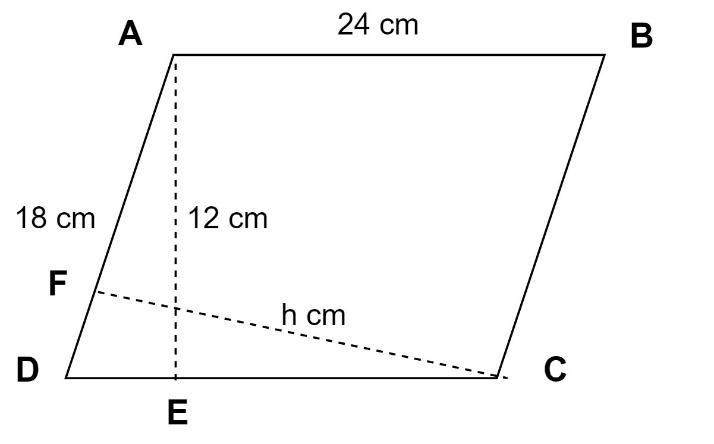
Two adjacent sides of a parallelogram are 24cm and 18cm. If the distance between the longer sides is 12cm, find the distance between the shorter sides.
A.9 cm
B.16 cm
C.24 cm
D.Data insufficient
Answer
608.4k+ views
Hint: First we need to draw the parallelogram to assign the given sides. Using the area of parallelogram, we can find the distance between the shorter sides.
Complete step-by-step answer:

Given the parallelogram ABCD with AB=24cm and AD=18cm.
Projecting a perpendicular line from vertex A to base DC at point E.
Since the distance between two lines is the perpendicular distance between them.
And the distance between the longer sides of the parallelogram is given 12cm in the problem.
Hence, AE=12cm
We know that area of the parallelogram is given by
Area = Base x Height
For parallelogram ABCD, Base=AB=CD=24cm, as the opposite sides of a parallelogram are equal. Similarly, Height=AE=12cm.
Therefore, area of parallelogram ABCD \[ = {\text{AB}} \times {\text{AE = 24}} \times 12 = 288{\text{cm}}\].
We can also consider the area of the parallelogram ABCD by considering the shorter aside as the base.
Considering the base of the parallelogram ABCD as AD=BC=18cm.
Projecting a perpendicular line from vertex C to base AD at point F, we get Height CF=h cm.
Now again,
Area = Base x Height
\[
\Rightarrow 288 = {\text{AD}} \times {\text{CF}} \\
\Rightarrow 288 = 18 \times {\text{h}} \\
\Rightarrow {\text{h = }}\dfrac{{288}}{{18}} = 16{\text{cm}} \\
\]
Hence CF=h=16 cm.
Since the distance between two lines is the perpendicular distance between them.
Distance between the shorter sides of the parallelogram ABCD = CF= 16cm.
Hence option (B) is the correct answer.
Note: It is important to draw the figure in the problems like above in order to solve the problem easily and accurately. Properties of the parallelogram should be kept in mind in solving the problems like above.
Complete step-by-step answer:

Given the parallelogram ABCD with AB=24cm and AD=18cm.
Projecting a perpendicular line from vertex A to base DC at point E.
Since the distance between two lines is the perpendicular distance between them.
And the distance between the longer sides of the parallelogram is given 12cm in the problem.
Hence, AE=12cm
We know that area of the parallelogram is given by
Area = Base x Height
For parallelogram ABCD, Base=AB=CD=24cm, as the opposite sides of a parallelogram are equal. Similarly, Height=AE=12cm.
Therefore, area of parallelogram ABCD \[ = {\text{AB}} \times {\text{AE = 24}} \times 12 = 288{\text{cm}}\].
We can also consider the area of the parallelogram ABCD by considering the shorter aside as the base.
Considering the base of the parallelogram ABCD as AD=BC=18cm.
Projecting a perpendicular line from vertex C to base AD at point F, we get Height CF=h cm.
Now again,
Area = Base x Height
\[
\Rightarrow 288 = {\text{AD}} \times {\text{CF}} \\
\Rightarrow 288 = 18 \times {\text{h}} \\
\Rightarrow {\text{h = }}\dfrac{{288}}{{18}} = 16{\text{cm}} \\
\]
Hence CF=h=16 cm.
Since the distance between two lines is the perpendicular distance between them.
Distance between the shorter sides of the parallelogram ABCD = CF= 16cm.
Hence option (B) is the correct answer.
Note: It is important to draw the figure in the problems like above in order to solve the problem easily and accurately. Properties of the parallelogram should be kept in mind in solving the problems like above.
Recently Updated Pages
Two men on either side of the cliff 90m height observe class 10 maths CBSE

What happens to glucose which enters nephron along class 10 biology CBSE

Cutting of the Chinese melon means A The business and class 10 social science CBSE

Write a dialogue with at least ten utterances between class 10 english CBSE

Show an aquatic food chain using the following organisms class 10 biology CBSE

A circle is inscribed in an equilateral triangle and class 10 maths CBSE

Trending doubts
The shortest day of the year in India

Why is there a time difference of about 5 hours between class 10 social science CBSE

Write a letter to the principal requesting him to grant class 10 english CBSE

What is the median of the first 10 natural numbers class 10 maths CBSE

The Equation xxx + 2 is Satisfied when x is Equal to Class 10 Maths

What is the missing number in the sequence 259142027 class 10 maths CBSE




